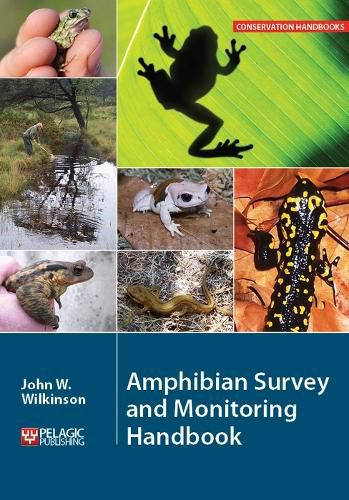Readings Newsletter
Become a Readings Member to make your shopping experience even easier.
Sign in or sign up for free!
You’re not far away from qualifying for FREE standard shipping within Australia
You’ve qualified for FREE standard shipping within Australia
The cart is loading…






This title is printed to order. This book may have been self-published. If so, we cannot guarantee the quality of the content. In the main most books will have gone through the editing process however some may not. We therefore suggest that you be aware of this before ordering this book. If in doubt check either the author or publisher’s details as we are unable to accept any returns unless they are faulty. Please contact us if you have any questions.
Evidence bases for conservation are becoming increasingly important to convince landowners and politicians of the need to take action in defence of species and habitats all around the world. A valuable feature of this book is its emphasis on collecting and analysing such essential information. Trevor Beebee, Phyllomedusa
Amphibians are among the most globally endangered groups of vertebrates with more than one-third of species being assessed as declining or threatened. Often, amphibian declines can be attributed to a suite of interacting factors, many of which are human in origin, but further information is needed to elaborate the key causes and to discover ways of reversing declines.
Robust surveys provide vital ecological and biological data on amphibian populations, and underpin the decisions made to protect species and reverse their declines. Ongoing monitoring informs land managers and decision makers about whether they are taking the right action. This book is designed to help you carry out amphibian surveying and monitoring so that the results of your surveys can be used effectively.
Part 1 introduces amphibians: order Anura (frogs and toads); Caudata (newts and salamanders); and order Gymnophonia (caecilians).
Part 2 is essential reading before you start surveying. It introduces the different types of survey and monitoring programmes and discusses survey aims and resources. It contains chapters on collecting and handling survey data; survey permissions and licencing; health and safety, and biosecurity; and handling amphibians.
Part 3 discusses everything you need to know during your survey, and provides a detailed look at amphibian survey methods.
Part 4 covers presenting and using your survey’s data to best effect.
A useful resources section is also provided, with example survey forms and details of additional information resources that will optimize the impacts of your surveys.
Key amphibian survey techniques are discussed with reference to published examples of successful surveys - so you’ll be able to choose what’s right for your situation. Tips on optimizing your survey effort and handling amphibians in the field are also included. Whether carrying out a student expedition project or seeking information to support the management of a protected area, this book contains essential advice from an amphibian ecologist who has encountered the same sorts of decisions you’ll face when planning your surveys.
$9.00 standard shipping within Australia
FREE standard shipping within Australia for orders over $100.00
Express & International shipping calculated at checkout
This title is printed to order. This book may have been self-published. If so, we cannot guarantee the quality of the content. In the main most books will have gone through the editing process however some may not. We therefore suggest that you be aware of this before ordering this book. If in doubt check either the author or publisher’s details as we are unable to accept any returns unless they are faulty. Please contact us if you have any questions.
Evidence bases for conservation are becoming increasingly important to convince landowners and politicians of the need to take action in defence of species and habitats all around the world. A valuable feature of this book is its emphasis on collecting and analysing such essential information. Trevor Beebee, Phyllomedusa
Amphibians are among the most globally endangered groups of vertebrates with more than one-third of species being assessed as declining or threatened. Often, amphibian declines can be attributed to a suite of interacting factors, many of which are human in origin, but further information is needed to elaborate the key causes and to discover ways of reversing declines.
Robust surveys provide vital ecological and biological data on amphibian populations, and underpin the decisions made to protect species and reverse their declines. Ongoing monitoring informs land managers and decision makers about whether they are taking the right action. This book is designed to help you carry out amphibian surveying and monitoring so that the results of your surveys can be used effectively.
Part 1 introduces amphibians: order Anura (frogs and toads); Caudata (newts and salamanders); and order Gymnophonia (caecilians).
Part 2 is essential reading before you start surveying. It introduces the different types of survey and monitoring programmes and discusses survey aims and resources. It contains chapters on collecting and handling survey data; survey permissions and licencing; health and safety, and biosecurity; and handling amphibians.
Part 3 discusses everything you need to know during your survey, and provides a detailed look at amphibian survey methods.
Part 4 covers presenting and using your survey’s data to best effect.
A useful resources section is also provided, with example survey forms and details of additional information resources that will optimize the impacts of your surveys.
Key amphibian survey techniques are discussed with reference to published examples of successful surveys - so you’ll be able to choose what’s right for your situation. Tips on optimizing your survey effort and handling amphibians in the field are also included. Whether carrying out a student expedition project or seeking information to support the management of a protected area, this book contains essential advice from an amphibian ecologist who has encountered the same sorts of decisions you’ll face when planning your surveys.